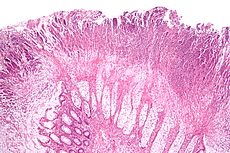Ischemic colitis pathophysiology
|
Ischemic colitis Microchapters |
|
Case Studies |
|
Ischemic colitis pathophysiology On the Web |
|
American Roentgen Ray Society Images of Ischemic colitis pathophysiology |
|
Risk calculators and risk factors for Ischemic colitis pathophysiology |
Editor-In-Chief: C. Michael Gibson, M.S., M.D. [1]; Associate Editor(s)-In-Chief: Hamid Qazi, MD, BSc [2] Cafer Zorkun, M.D., Ph.D. [3]
Pathophysiology
The pathophysiology of ischemic colitis is as follows:[1][2][3]
Colonic Blood Supply
- Colon receives blood from both the superior and inferior mesenteric arteries.
- Blood supply from these two major arteries overlap, with abundant collateral circulation.
- There are weak points, or "watershed" areas, at the borders of the territory supplied by each of these arteries.
- These watershed areas are most vulnerable to ischemia when blood flow decreases, as they have the fewest vascular collaterals.
- Rectum receives blood from the inferior mesenteric artery and the internal iliac artery
- Rectum is rarely involved by colonic ischemia due to this dual blood supply.
Development of Ischemia
- Under ordinary conditions, the colon receives between 10% and 35% of the total cardiac output.
- If blood flow to the colon drops by more than about 50%, ischemia will develop.
- The arteries feeding the colon are very sensitive to vasoconstrictors
- During periods of low blood pressure, the arteries feeding the colon clamp down vigorously.
- A similar process can result from vasoconstricting drugs such as ergotamine, cocaine, or vasopressors.
- This can result in non-occlusive ischemic colitis.
Microscopic Pathology
- A range of pathologic findings are seen in ischemic colitis, corresponding to the spectrum of clinical severity.
- In its mildest form, mucosal and submucosal hemorrhage and edema are seen, possibly with mild necrosis or ulceration.
- With more severe ischemia, a pathologic picture resembling inflammatory bowel disease (i.e. chronic ulcerations, crypt abscesses and pseudopolyps) may be seen.
- In the most severe cases, transmural infarction with resulting perforation may be seen.
- After recovery, the muscularis propria may be replaced by fibrous tissue, resulting in a stricture.
- Following restoration of normal blood flow, reperfusion injury may also contribute to the damage to the colon.
Images

Micrograph of a colonic pseudomembrane, a finding that may be associated with ischemic colitis. H&E stain.
Videos
{{#ev:youtube|LCwMQU7ylYg}}
References
- ↑ Rosenblum J, Boyle C, Schwartz L (1997). "The mesenteric circulation. Anatomy and physiology". Surg Clin North Am. 77 (2): 289–306. PMID 9146713.
- ↑ Granger D, Rutili G, McCord J (1981). "Superoxide radicals in feline intestinal ischemia". Gastroenterology. 81 (1): 22–9. PMID 6263743.
- ↑ Brandt LJ, Boley SJ, Goldberg L, et al: Colitis in the elderly. Am J Gastroenterol 76:239, 1981.